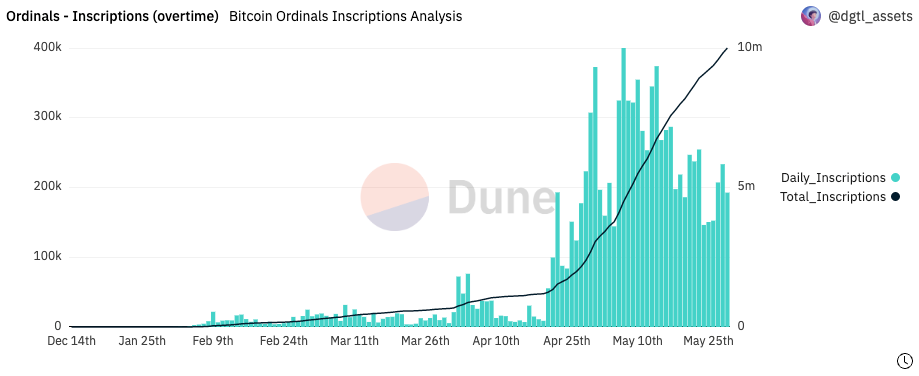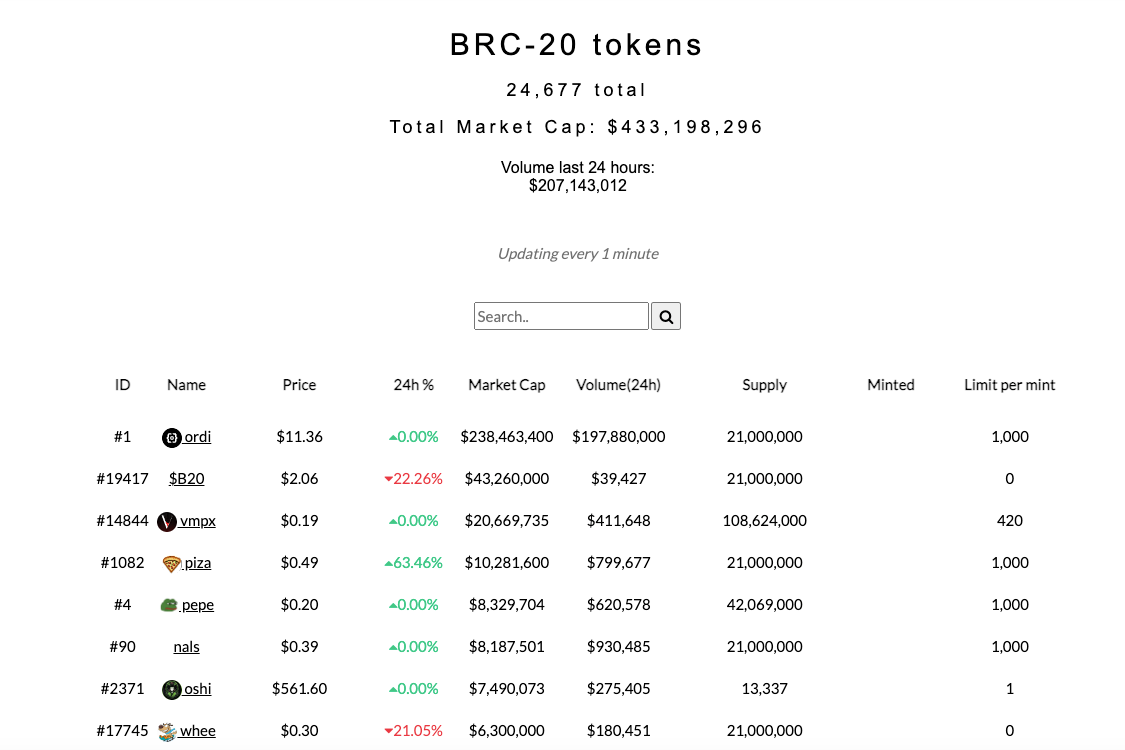Shortly after founder Casey Rodarmor resigned as caretaker, Bitcoin Ordinals, a popular way to create assets on the blockchain, have topped 10 million inscriptions, marking a significant milestone. Over 25,000 Bitcoin-based tokens have been generated, which furthered the rise once the BRC-20 token standard was introduced.
Founder Resigns as Bitcoin’s Ordinals Project Custodian
Shortly after its founder, Casey Rodarmor, resigned as the project’s custodian, Bitcoin Ordinals reached a new milestone by surpassing 10 million inscriptions on the BTC network.
Casey Rodarmor announced on Twitter on May 28 that he was resigning as the project’s lead maintainer because he could not give Bitcoin Ordinals the attention it required. Coder Raphjaph, who uses the alias Rodarmor, was given the position.
The Ordinals protocol was launched in January and quickly became the most well-liked method of creating new assets on the Bitcoin blockchain. Ordinals, written onto individual satoshis, the smallest divisible unit of BTC, were first developed to inscribe data in the witness section of bitcoin transactions.
I haven't been able to give ord the attention it deserves, so I am pleased to announce that @raphjaph has agreed to step up as lead maintainer!
— Casey (@rodarmor) May 28, 2023
Raph is an impoverished student, and his work on ord will be entirely funded by donations. If you can, please consider donating!…
The introduction of the BRC-20 token standard in early March, however, really put a spike in the number of Bitcoin Ordinals inscriptions. Users could create new tokens on the Bitcoin network for the first time due to the new token standard created by developer “Domo,” who goes by only his pseudonym.

According to data from BRC-20.io, the number of Bitcoin-based tokens exploded from a few hundred in the first week to more than 25,000 at the time of publication.
Many Bitcoin supporters have criticized the practice of inscribing assets on the network as being wasteful and inefficient, particularly in terms of block space and transaction fees, as the use of Ordinals has not been disputed.
As a result, other developers are looking into using smart contracts to create Bitcoin assets and NFTs.
On the other hand, the potential of Bitcoin Ordinals to integrate new users into the larger Bitcoin community has been praised by Bitcoin proponents. Peter Schiff, a vigorous opponent of Bitcoin, recently created a limited number of NFTs on bitcoin using the Ordinals protocol.
According to statistics from Dune Analytics, the surge in network activity has benefited miners, who have now received more than $44 million in fees related to Ordinals, even if it is evident that Ordinals have played a significant role in the spike in bitcoin transaction costs.

Bitcoin Ordinals market and BTC Miladys collaborate on BRC-721E Standard
The BRC-721E standard, jointly released by the Bitcoin NFT market Ordinals Market and Bitcoin Miladys, allows irreversible, verifiable ERC-721 NFTs to be transferred to Bitcoin Ordinals without embedding the complete NFT series.
The Ethereum smart contract token standard for NFTs, ERC-721 tokens, inspires BRC-721 tokens. Constructing oracles that search the Bitcoin blockchain for certain transactions will be simple, and then relaying that data to wallets or markets if there is a standard file and metadata to source from.
The BRC-721E bridges NFTs by directly encoding data into a burn transaction that designates a Bitcoin address to receive the inscription. Before BRC-721E, Teleburn required knowledge of the inscription ID before allowing the destruction of the ETH NFT. However, BRC-721E permits destruction before burning, implying that the destruction transaction serves as an inscription request on the chain and can be used by users to obtain airdrops.
Are Bitcoin ordinals the next big thing?
An ordinal is, in essence, a piece of data that has been added to the bitcoin blockchain and is referred to by a specific address that is likewise stored in the blockchain data structure.
Similar in sound to a non-fungible token (NFT), an NFT is a token that refers to actual data stored elsewhere on the internet, such as IPFS (inter-planetary file system). The problem is that if the file or its storage disappears, the NFT data is lost, leaving merely the token pointing to nothing. It may be somewhere else.
The Bored Monkeys or Punks may have long since vanished in a fog of bit rot, but Ether (ETH) may still be operating a century from now.
An ordinal is stored in a bitcoin block. Therefore the information is present as long as bitcoin BTC or its forks are active. It can only be eliminated if bitcoin and every blockchain instance are destroyed. That is virtually unimaginable.
The Bitcoin community is in a frenzy because of the Ordinals protocol. The new protocol enables arbitrary data to be inserted on the Bitcoin blockchain and has already amassed over 9,000,000 inscriptions. The fees needed to send bitcoin have significantly increased due to Ordinals, drawing attention from the NFT sector and igniting fresh discussion about how bitcoin should handle situations with high fees.





